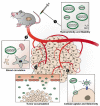Applications of Pristine and Functionalized Carbon Nanotubes, Graphene, and Graphene Nanoribbons in Biomedicine
- PMID: 34835783
- PMCID: PMC8626004
- DOI: 10.3390/nano11113020
Applications of Pristine and Functionalized Carbon Nanotubes, Graphene, and Graphene Nanoribbons in Biomedicine
Abstract
This review is dedicated to a comprehensive description of the latest achievements in the chemical functionalization routes and applications of carbon nanomaterials (CNMs), such as carbon nanotubes, graphene, and graphene nanoribbons. The review starts from the description of noncovalent and covalent exohedral modification approaches, as well as an endohedral functionalization method. After that, the methods to improve the functionalities of CNMs are highlighted. These methods include the functionalization for improving the hydrophilicity, biocompatibility, blood circulation time and tumor accumulation, and the cellular uptake and selectivity. The main part of this review includes the description of the applications of functionalized CNMs in bioimaging, drug delivery, and biosensors. Then, the toxicity studies of CNMs are highlighted. Finally, the further directions of the development of the field are presented.
Keywords: bioimaging; biological applications; biosensing; carbon nanotubes; drug delivery; functionalization; graphene; graphene nanoribbons; nanomaterial toxicity.
Conflict of interest statement
The authors declare no conflict of interest.
Figures









References
-
- Burdanova M.G., Tsapenko A.P., Satco D.A., Kashtiban R., Mosley C.D.W., Monti M., Staniforth M., Sloan J., Gladush Y.G., Nasibulin A.G., et al. Giant Negative Terahertz Photoconductivity in Controllably Doped Carbon Nanotube Networks. ACS Photonics. 2019;6:1058–1066. doi: 10.1021/acsphotonics.9b00138. - DOI
-
- Gladush Y., Mkrtchyan A.A., Kopylova D.S., Ivanenko A., Nyushkov B., Kobtsev S., Kokhanovskiy A., Khegai A., Melkumov M., Burdanova M., et al. Ionic Liquid Gated Carbon Nanotube Saturable Absorber for Switchable Pulse Generation. Nano Lett. 2019;19:5836–5843. doi: 10.1021/acs.nanolett.9b01012. - DOI - PubMed
-
- Burdanova M.G., Liu M., Staniforth M., Zheng Y., Xiang R., Chiashi S., Anisimov A., Kauppinen E.I., Maruyama S., Lloyd-Hughes J. Intertube Excitonic Coupling in Nanotube Van der Waals Heterostructures. Adv. Funct. Mater. 2021:2104969. doi: 10.1002/adfm.202104969. - DOI
-
- Deng S., Berry V. Wrinkled, rippled and crumpled graphene: An overview of formation mechanism, electronic properties, and applications. Mater. Today. 2016;19:197–212. doi: 10.1016/j.mattod.2015.10.002. - DOI
Publication types
Grants and funding
LinkOut - more resources
Full Text Sources

